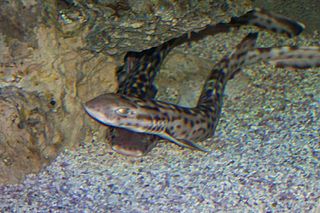
Atelomycterus is a genus of catsharks in the family Scyliorhinidae.

The Bali catshark is a species of catshark, belonging to the family Scyliorhinidae, found only off the Indonesian island of Bali. It can grow up to 47 cm (19 in). Atelomycterus baliensis inhabits the deep coastal waters of Bali, Indonesia, feeding on small fish and invertebrates.
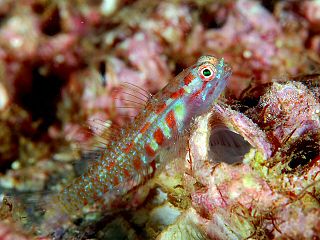
Eviota is a genus of fish in the family Gobiidae, commonly as dwarfgobies found in the Indo-Pacific region, where it is distributed from Japan to Australia and from Africa to Pitcairn Island. Species are mainly associated with coral reefs. Many of these fish are short-lived, with life cycles as brief as 3.5 weeks in the tropics. Some species are hermaphrodites and some representatives live symbiotically among the tentacles of the mushroom coral.

Euphyllia divisa, commonly known as frogspawn coral and sometimes misspelled Euphyllia divisia, is a large-polyped stony coral native to the Indo-Pacific islands. It is a commonly kept species in the marine aquarium hobby. The related coral Fimbriaphyllia paradivisa is frequently misidentified as frogspawn leading to some confusion. Fimbriaphyllia divisa has a corallite skeleton with a flabello-meandroid "wall" structure whereas Fimbriaphyllia paradivisa has a tree-like branching structure with separate corallites.
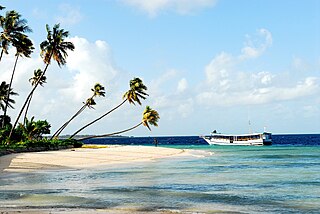
Wakatobi National Park is a marine national park in Southeast Sulawesi, Indonesia. The name of Wakatobi is a portmanteau of the four main Tukangbesi Islands: Wangi-wangi, Kaledupa, Tomia, and Binongko. Since 2005 the park is listed as a tentative World Heritage Site.
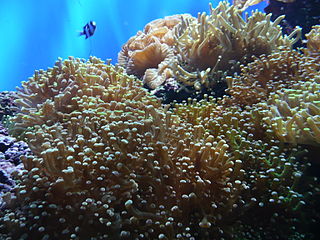
Euphyllia is a genus of large-polyped stony coral. Several species are commonly found in marine aquariums. The genus includes the following species:

Galaxea is a genus of colonial stony corals in the family Euphylliidae. Common names include crystal, galaxy, starburst and tooth coral. They are abundant on reefs in the Indo-Pacific region and the Red Sea. They are found in water less than 20 metres (66 ft) deep and favour turbid sites. They are sometimes kept in reef aquaria.

Galaxea fascicularis is a species of colonial stony coral in the family Euphylliidae, commonly known as Octopus coral, Fluorescence grass coral, and Galaxy coral among various vernacular names.
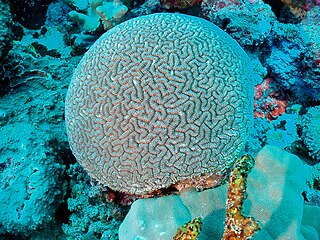
Ctenella is a monotypic genus of stony coral in the family Euphylliidae. It is represented by a single species, Ctenella chagius. These corals are massive in size with meandering valleys between the calyces which have solid, non-porous walls and fine, evenly spaced, solid septae. They are found in the Indian Ocean, Red Sea and Mediterranean Sea. It forms solid, smooth hemispherical domes and is found in the Indian Ocean in the vicinity of the Chagos Archipelago.

Euphyllia ancora is a species of hard coral in the family Euphylliidae. It is known by several common names, including anchor coral and hammer coral, or less frequently as sausage coral, ridge coral, or bubble honeycomb coral.

Euphyllia cristata is commonly called Grape coral. E. cristata is a kind of stony or hard coral in the family Euphylliidae; it also belongs to the genus Euphyllia in the order of Scleractinia. E. cristata has a wide range of distribution throughout the tropical waters of the Indo-West Pacific area with a large presence in Indonesia. However, despite this large range of distribution, E. cristata has a slightly lower abundance compared to other species, making them a little more uncommon to find. They are typically found in shallow waters from 1–35 meters deep.

Catalaphyllia is a monotypic genus of stony coral in the family Euphylliidae from the western Pacific Ocean. It is represented by a single species, Catalaphyllia jardinei, commonly known as elegance coral. It was first described by William Saville-Kent in 1893 as Pectinia jardinei.
Kozakia baliensis is a species of acetic acid bacteria, with type strain Yo-3T. It is the type species of its genus.
Euphyllia paradivisa, or branching frogspawn coral, is a species of large-polyped stony coral belonging to the Euphylliidae family. It shares the common name of "frogspawn coral" with Euphyllia divisa, but is differentiated as the "branching" frogspawn whereas Euphyllia divisa has a "wall" structure. It is a commonly kept species in the marine aquarium hobby.
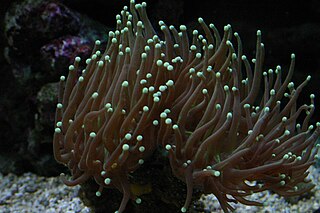
Euphyllia glabrescens is a species of large-polyped stony coral belonging to the family Euphylliidae. Its common name is the torch coral due to its long sweeper tentacles tipped with potent cnidocytes. It is a commonly kept species in the marine aquarium hobby, particularly specimens from Indonesia and Fiji, who fulfilled annual export quotas of 28,000 and 6,000 pieces, respectively, in 2005.
Euphyllia paraglabrescens is a species of large-polyped stony coral belonging to the Euphylliidae family. The International Union for Conservation of Nature has listed it as a vulnerable species, stating "its threat susceptibility increases the likelihood of being lost within one generation."

Euphylliidae are known as a family of polyped stony corals under the order Scleractinia.
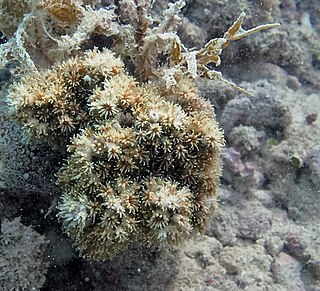
Galaxea acrhelia is a large polyp stony coral in the family Euphylliidae.
Bubble coral may refer to two different species of sea anemone:















